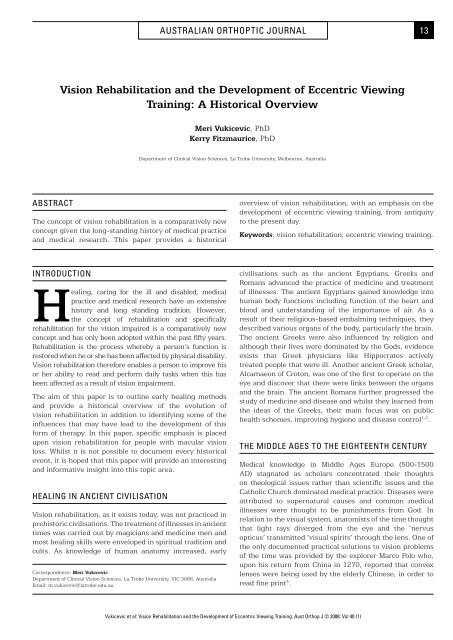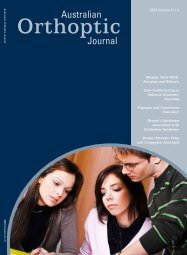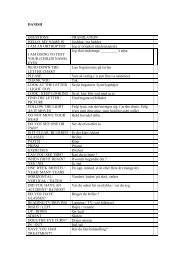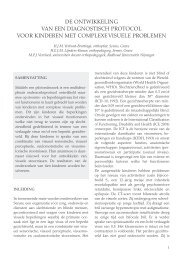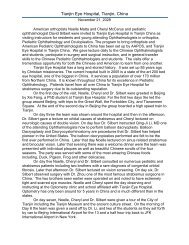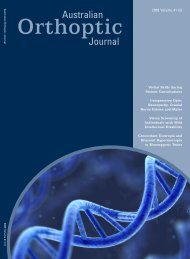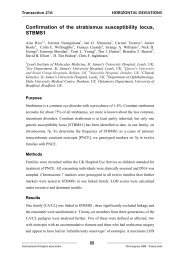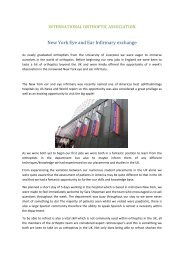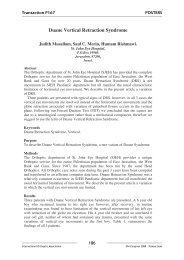Advertising in the Australian Orthoptic Journal - International ...
Advertising in the Australian Orthoptic Journal - International ...
Advertising in the Australian Orthoptic Journal - International ...
You also want an ePaper? Increase the reach of your titles
YUMPU automatically turns print PDFs into web optimized ePapers that Google loves.
australian orthoptic journal 13<br />
Vision Rehabilitation and <strong>the</strong> Development of Eccentric View<strong>in</strong>g<br />
Tra<strong>in</strong><strong>in</strong>g: A Historical Overview<br />
Meri Vukicevic, PhD<br />
Kerry Fitzmaurice, PhD<br />
Department of Cl<strong>in</strong>ical Vision Sciences, La Trobe University, Melbourne, Australia<br />
Abstract<br />
The concept of vision rehabilitation is a comparatively new<br />
concept given <strong>the</strong> long-stand<strong>in</strong>g history of medical practice<br />
and medical research. This paper provides a historical<br />
overview of vision rehabilitation, with an emphasis on <strong>the</strong><br />
development of eccentric view<strong>in</strong>g tra<strong>in</strong><strong>in</strong>g, from antiquity<br />
to <strong>the</strong> present day.<br />
Keywords: vision rehabilitation; eccentric view<strong>in</strong>g tra<strong>in</strong><strong>in</strong>g.<br />
Introduction<br />
Heal<strong>in</strong>g, car<strong>in</strong>g for <strong>the</strong> ill and disabled, medical<br />
practice and medical research have an extensive<br />
history and long stand<strong>in</strong>g tradition. However,<br />
<strong>the</strong> concept of rehabilitation and specifically<br />
rehabilitation for <strong>the</strong> vision impaired is a comparatively new<br />
concept and has only been adopted with<strong>in</strong> <strong>the</strong> past fifty years.<br />
Rehabilitation is <strong>the</strong> process whereby a person’s function is<br />
restored when he or she has been affected by physical disability.<br />
Vision rehabilitation <strong>the</strong>refore enables a person to improve his<br />
or her ability to read and perform daily tasks when this has<br />
been affected as a result of vision impairment.<br />
The aim of this paper is to outl<strong>in</strong>e early heal<strong>in</strong>g methods<br />
and provide a historical overview of <strong>the</strong> evolution of<br />
vision rehabilitation <strong>in</strong> addition to identify<strong>in</strong>g some of <strong>the</strong><br />
<strong>in</strong>fluences that may have lead to <strong>the</strong> development of this<br />
form of <strong>the</strong>rapy. In this paper, specific emphasis is placed<br />
upon vision rehabilitation for people with macular vision<br />
loss. Whilst it is not possible to document every historical<br />
event, it is hoped that this paper will provide an <strong>in</strong>terest<strong>in</strong>g<br />
and <strong>in</strong>formative <strong>in</strong>sight <strong>in</strong>to this topic area.<br />
HEALING IN ANCIENT CIVILISATION<br />
Vision rehabilitation, as it exists today, was not practiced <strong>in</strong><br />
prehistoric civilisations. The treatment of illnesses <strong>in</strong> ancient<br />
times was carried out by magicians and medic<strong>in</strong>e men and<br />
most heal<strong>in</strong>g skills were enveloped <strong>in</strong> spiritual tradition and<br />
cults. As knowledge of human anatomy <strong>in</strong>creased, early<br />
Correspondence: Meri Vukicevic<br />
Department of Cl<strong>in</strong>ical Vision Sciences, La Trobe University, VIC 3086, Australia<br />
Email: m.vukicevic@latrobe.edu.au<br />
civilisations such as <strong>the</strong> ancient Egyptians, Greeks and<br />
Romans advanced <strong>the</strong> practice of medic<strong>in</strong>e and treatment<br />
of illnesses. The ancient Egyptians ga<strong>in</strong>ed knowledge <strong>in</strong>to<br />
human body functions <strong>in</strong>clud<strong>in</strong>g function of <strong>the</strong> heart and<br />
blood and understand<strong>in</strong>g of <strong>the</strong> importance of air. As a<br />
result of <strong>the</strong>ir religious-based embalm<strong>in</strong>g techniques, <strong>the</strong>y<br />
described various organs of <strong>the</strong> body, particularly <strong>the</strong> bra<strong>in</strong>.<br />
The ancient Greeks were also <strong>in</strong>fluenced by religion and<br />
although <strong>the</strong>ir lives were dom<strong>in</strong>ated by <strong>the</strong> Gods, evidence<br />
exists that Greek physicians like Hippocrates actively<br />
treated people that were ill. Ano<strong>the</strong>r ancient Greek scholar,<br />
Alcamaeon of Croton, was one of <strong>the</strong> first to operate on <strong>the</strong><br />
eye and discover that <strong>the</strong>re were l<strong>in</strong>ks between <strong>the</strong> organs<br />
and <strong>the</strong> bra<strong>in</strong>. The ancient Romans fur<strong>the</strong>r progressed <strong>the</strong><br />
study of medic<strong>in</strong>e and disease and whilst <strong>the</strong>y learned from<br />
<strong>the</strong> ideas of <strong>the</strong> Greeks, <strong>the</strong>ir ma<strong>in</strong> focus was on public<br />
health schemes, improv<strong>in</strong>g hygiene and disease control 1-3 .<br />
THE MIDDLE AGES TO THE EIGHTEENTH CENTURY<br />
Medical knowledge <strong>in</strong> Middle Ages Europe (500-1500<br />
AD) stagnated as scholars concentrated <strong>the</strong>ir thoughts<br />
on <strong>the</strong>ological issues ra<strong>the</strong>r than scientific issues and <strong>the</strong><br />
Catholic Church dom<strong>in</strong>ated medical practice. Diseases were<br />
attributed to supernatural causes and common medical<br />
illnesses were thought to be punishments from God. In<br />
relation to <strong>the</strong> visual system, anatomists of <strong>the</strong> time thought<br />
that light rays diverged from <strong>the</strong> eye and <strong>the</strong> ‘nervus<br />
opticus’ transmitted ‘visual spirits’ through <strong>the</strong> lens. One of<br />
<strong>the</strong> only documented practical solutions to vision problems<br />
of <strong>the</strong> time was provided by <strong>the</strong> explorer Marco Polo who,<br />
upon his return from Ch<strong>in</strong>a <strong>in</strong> 1270, reported that convex<br />
lenses were be<strong>in</strong>g used by <strong>the</strong> elderly Ch<strong>in</strong>ese, <strong>in</strong> order to<br />
read f<strong>in</strong>e pr<strong>in</strong>t 4 .<br />
Vukicevic et al: Vision Rehabilitation and <strong>the</strong> Development of Eccentric View<strong>in</strong>g Tra<strong>in</strong><strong>in</strong>g: Aust Orthop J © 2008: Vol 40 (1)


